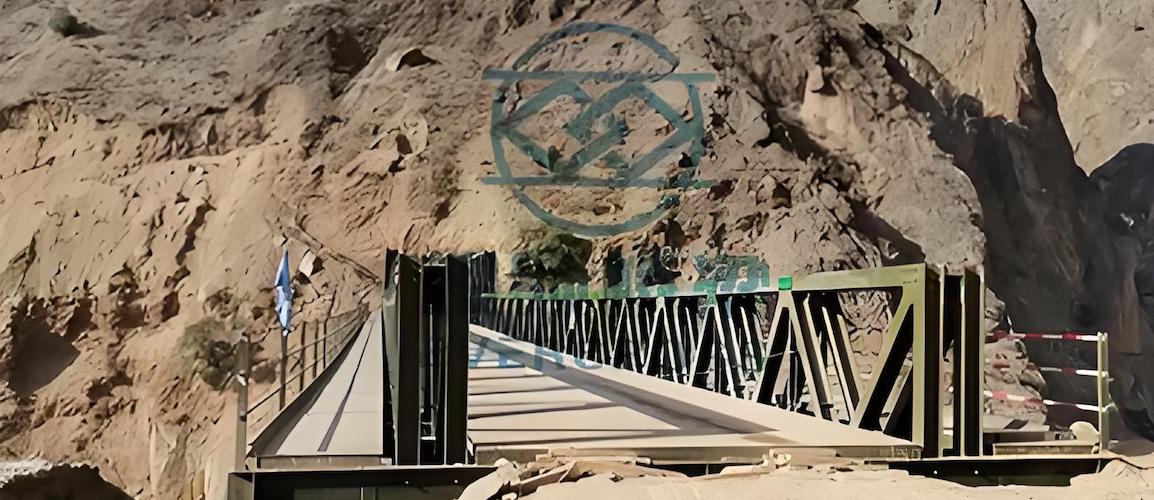Views: 211 Author: Site Editor Publish Time: 2025-11-04 Origin: Site









Content Menu
● Structural Characteristics of the HBD60 Bridge
>>> Dimensions and Specifications
● Advantages of the HBD60 Bridge
● Transportation and Storage Considerations
>> Documentation and Quality Assurance
● Frequently Asked and Questions regarding HBD60 Type Prefabricated Highway Steel Bridge
>> 1. What are the typical load capacities for HBD60 bridges in different configurations?
>> 4. Can the HBD60 bridge be adapted for use in seismic zones?
>> 5. What maintenance practices are recommended for the HBD60 bridge to ensure longevity?
The HBD60 Type Prefabricated Highway Steel Bridge represents a significant advancement in bridge engineering, combining innovative design with practical applications. This article will explore the various aspects of the HBD60 bridge, including its origins, structural characteristics, advantages, and considerations for transportation and storage.
The HBD60 bridge has its roots in Germany, where its design was initially developed. Engineers recognized the need for a more efficient and adaptable bridge structure, leading to the introduction of the HBD60 model in China for mass production. This bridge type emerged as a solution to the limitations of traditional Bailey bridges, which, despite their widespread use, faced challenges in terms of span length and load capacity.
Bailey bridges are known for their simple assembly and strong adaptability. However, they typically have a maximum single-span length of only 60 meters, which can be a significant limitation for many infrastructure projects. The introduction of the HBD60 bridge aimed to overcome these constraints by utilizing a more robust design that allows for longer spans while maintaining structural integrity. This innovation not only addresses the practical needs of modern transportation networks but also reflects a broader trend in engineering towards more sustainable and efficient construction practices.
The HBD60 Type Prefabricated Highway Steel Bridge is characterized by its unique structural design, which includes several key components that contribute to its strength and versatility.
The HBD60 bridge typically features a three-chord truss design, which consists of various standard components such as end trusses, standard truss segments, chord members, and bracing elements. This design not only enhances the bridge's load-bearing capacity but also simplifies the assembly process. The use of a truss system allows for a lightweight yet strong structure, making it ideal for various applications, from rural roads to major highways.
The standard truss length for the HBD60 bridge is 3.048 meters, with a single-layer height of 2.250 meters and a double-layer height of 4.500 meters. The bridge is designed to accommodate two trusses on one side, with the roadway constructed using either cast-in-place reinforced concrete or a steel deck. This flexibility in design allows for various applications, from highways to railways. The ability to customize dimensions based on specific project requirements further enhances the bridge's appeal to engineers and project managers.
One of the standout features of the HBD60 bridge is its use of high-strength bolt connections for the main truss. This method ensures a secure and stable assembly, which is crucial for maintaining the bridge's structural integrity under load. The ease of assembly is a significant advantage, allowing for quicker installation times compared to traditional bridge types. This rapid assembly process can significantly reduce labor costs and project timelines, making the HBD60 an attractive option for contractors facing tight deadlines.
The HBD60 Type Prefabricated Highway Steel Bridge offers numerous advantages that make it an attractive option for infrastructure projects.
One of the primary benefits of the HBD60 bridge is its ability to achieve longer spans compared to traditional Bailey bridges. This capability reduces the need for numerous piers, which can significantly lower construction costs and time. The increased span length also allows for more flexible design options in various terrains. This is particularly beneficial in areas where the installation of multiple supports would be challenging due to environmental or geological conditions.
By utilizing a prefabricated design, the HBD60 bridge can be produced in a controlled environment, leading to higher quality and reduced waste. The efficiency of the manufacturing process translates to lower overall costs for projects, making it a financially viable option for governments and contractors alike. Additionally, the durability of the materials used in the HBD60 bridge contributes to lower maintenance costs over its lifespan, further enhancing its cost-effectiveness.
The HBD60 bridge is suitable for a wide range of applications, including highways, railways, and even international government procurement projects. Its adaptability to different environments and load requirements makes it a preferred choice for many engineering firms. The bridge's design can be tailored to meet specific project needs, whether it involves accommodating heavy traffic loads or integrating with existing infrastructure.
Transporting and storing the components of the HBD60 bridge requires careful planning to ensure that the integrity of the materials is maintained throughout the process.
During the loading, transportation, and unloading of bridge components, it is crucial to avoid damage to the paint finish and prevent collisions that could lead to deformation. Proper handling techniques must be employed to ensure that each component arrives at the construction site in optimal condition. This includes using specialized equipment and trained personnel to manage the logistics of transporting large and heavy components safely.
Utilizing various transportation methods can enhance the efficiency of moving bridge components. Regardless of the chosen method, minimizing intermediate transport stages is essential to reduce the risk of damage and ensure timely delivery. This may involve coordinating with multiple transportation providers to streamline the process and ensure that all components arrive at the site simultaneously.
Manufacturers should provide users with essential documentation, including product quality certificates, a list of components, and detailed instructions for the use of the steel bridge. This information is vital for ensuring that the bridge is assembled correctly and functions as intended. Clear documentation also facilitates communication between manufacturers and contractors, helping to prevent misunderstandings and ensuring that all parties are aligned on project specifications.
The protective coatings on steel components are critical for preventing corrosion and ensuring longevity. During storage and transport, it is essential to safeguard these coatings. Any damage should be promptly repaired according to established procedures to maintain the bridge's durability. Implementing a routine inspection process for coatings can help identify potential issues early, allowing for timely maintenance and extending the lifespan of the bridge.
The HBD60 Type Prefabricated Highway Steel Bridge represents a significant advancement in bridge technology, offering enhanced span capabilities, cost-effectiveness, and versatility. Its design, rooted in German engineering principles, has been successfully adapted for mass production in China, making it a valuable asset for modern infrastructure projects. As the demand for efficient and durable bridge solutions continues to grow, the HBD60 bridge stands out as a leading choice for engineers and contractors worldwide. Its combination of innovative design, practical applications, and economic benefits positions it as a key player in the future of bridge construction.

The HBD60 bridges are designed to support various load capacities depending on their configuration. Typically, they can handle loads ranging from 20 to 60 tons for standard highway applications. However, specific configurations can be tailored to accommodate heavier loads, making them suitable for both vehicular and railway traffic.
The HBD60 bridge is generally more cost-effective than many traditional bridge systems due to its prefabricated nature, which reduces on-site labor and construction time. Assembly can often be completed in a matter of days, compared to weeks or months for conventional bridges. This efficiency translates to lower overall project costs and faster completion times.
Common challenges during assembly include ensuring precise alignment of components and managing the logistics of transporting large sections. These can be mitigated by employing experienced assembly teams, using advanced alignment tools, and planning transportation routes carefully to avoid delays and damage.
Yes, the HBD60 bridge can be designed to meet seismic requirements. Engineers can incorporate specific design features, such as flexible joints and reinforced connections, to enhance the bridge's performance in seismic events, ensuring safety and stability.
Regular inspections should be conducted to check for signs of wear, corrosion, or damage to the protective coatings. Maintenance practices include cleaning the bridge surface, repairing any damaged coatings promptly, and ensuring that all connections remain secure. Implementing a routine maintenance schedule can significantly extend the lifespan of the bridge.
